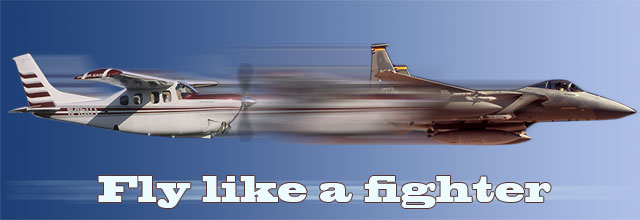 Flying the T-38 in pilot training, we would pull up to 5Gs during acrobatics, generally only having to look straight ahead. After advancing to the AT-38 for the “Introduction to Fighter Fundamentals” course, we would pull up to 6Gs during our initial maneuvering in one-on-one dogfighting. When on the defensive, we used some rarely used neck and shoulder muscles while holding a descending 4- to 5-G turn, all the while maintaining awareness of our own jet’s airspeed and altitude and watching the attacking aircraft behind us.
Flying the T-38 in pilot training, we would pull up to 5Gs during acrobatics, generally only having to look straight ahead. After advancing to the AT-38 for the “Introduction to Fighter Fundamentals” course, we would pull up to 6Gs during our initial maneuvering in one-on-one dogfighting. When on the defensive, we used some rarely used neck and shoulder muscles while holding a descending 4- to 5-G turn, all the while maintaining awareness of our own jet’s airspeed and altitude and watching the attacking aircraft behind us.
When I first transitioned to the F-15, I figured it would be just another step up in physical fitness to handle the higher G loads. After our F-15 aircraft conversion, instrument checkride, and radar intercept training, we moved to offensive dogfighting. Now pulling 7Gs during the initial maneuvering, my muscles had to work a little harder, but I was still able to monitor and track the bandit ahead of me.
For my first defensive ride I was in the F-15B “family model” with an instructor in the back seat. We started with some ranging exercises to calibrate our eyeballs while looking behind us and did some turning exercises at 4Gs to practice some basic dogfighting maneuvers under controlled conditions. It was then time to do my first dogfight.

Holding 420 knots, I started a 2- to 3-G level left turn while the instructor in the attacking F-15, 9,000 feet behind me, pointed his nose at me and counted down the range as he closed in: “9,000…8,000…7,000…6,000, fights on!” As briefed, my initial move was to light full afterburner and roll to about 90 degrees of bank and start my 7-G break turn into the attacker. The airplane responded to my inputs, and my head slumped slightly down under the G forces as I strained to keep it from falling down any more. I was now staring clearly at the lower left part of the cockpit. Yep, the G meter was showing 7 Gs. Airspeed was still around 420 knots. My left hand had a firm grasp on the throttles, shoved full forward. The problem, however, was I couldn’t lift my head to see out of the cockpit.
No matter. I just listened and responded to the commentary from my instructor: “Nice move … OK, keep your turn coming … his nose is coming back—increase your bank a little … now level out your turn … keep pulling ….” The next radio call from the other jet was “Jester 1, BINGO fuel, knock it off.” The next comment from my instructor was, “Wow, you did great for your first engagement, and he never got a shot on you!” I never did tell him that I only saw the inside of my cockpit during the fight.
As you might transition to a different type of flying—tailwheel, technically advanced aircraft, high performance, or turboprop—don’t assume that the next incremental step up is a small one. Be prepared for a bigger leap in piloting than you might expect. For you instructors out there, one difficult, but important task is monitoring where your students are looking. My F-15 instructor spent the engagement looking back at the attacker and never saw where my head was pointing. Finally, while my physical condition was easily self critiqued, don’t be afraid to admit your flying mistakes. Over your flying career, you will learn so much more if you do.
Larry Brown of Colorado Springs, Colo., is a retired Air Force F-15 pilot who is using the lessons he learned as a fighter pilot as a GA pilot in his Cessna P210. Brown, who has 2,700 hours total time during his 33 years of flying, also was an instructor pilot and flight examiner in the Air Force T-38 and instructor pilot in the T-52, the military’s version of GA’s Diamond DA40. See previous installments of “Fly like a fighter.”



